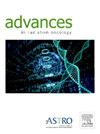Concurrent Radiation and Immunotherapy for Unresectable Hepatocellular Carcinoma With Extensive Portal Vein Tumor Thrombus
IF 2.7
Q3 ONCOLOGY
引用次数: 0
Abstract
Purpose
While immunotherapy has been established as the standard of care for patients with Barcelona Clinic for Liver Cancer class C hepatocellular carcinoma (HCC), outcomes for patients with portal vein thrombus (PVT) remain poor. This study evaluates the benefit of radiation therapy (RT) in addition to immunotherapy for patients with advanced PVT.
Methods and Materials
A retrospective chart screen was performed to identify patients with HCC with PVT treated with definitive RT with concurrent (defined as within 6 weeks) immunotherapy. Kaplan-Meier survival analysis was performed to assess progression-free survival (PFS) and overall survival (OS). Cox proportional hazard modeling was employed for each covariate using R software version 4.3.3.
Results
Sixty-two patients met the inclusion criteria from 2016 to 2023. The median follow-up was 18.9 months. Most patients were male (85.8%), with a median age of 64, and 61% had Child-Turcotte-Pugh (CTP) A liver function. Treatments included stereotactic body RT (61%) or fractionated RT (39%) with immunotherapy (74% single-agent). Portal vein tumor thrombosis classifications were Vp3 (47%) and Vp4 (45%). Median overall PFS was 3.70 months, and OS was 7.7 months. Patients with CTP A had better outcomes (PFS 5.3 months, OS 10.2 months; PFS hazard ratio 2.13, OS hazard ratio 3.08, P < .05). There was no significant difference in PFS or OS for patients who received single-agent immunotherapy with radiation versus multiagent immunotherapy (atezolizumab-bevacizumab) with radiation. Multivariate analysis identified no other significant predictors.
Conclusions
The addition of radiation to immunotherapy may improve outcomes for patients with advanced PVT with HCC who have inferior outcomes with immunotherapy alone. Particularly for patients with CTP A liver function who would be eligible for clinical trials, the addition of radiation may improve OS beyond reported outcomes. Prospective studies are needed to verify these results.
放疗与免疫同步治疗不可切除肝细胞癌伴广泛门静脉肿瘤血栓
目的:虽然免疫治疗已被确立为巴塞罗那肝癌诊所C级肝细胞癌(HCC)患者的标准治疗,但门静脉血栓(PVT)患者的预后仍然很差。本研究评估放射治疗(RT)和免疫治疗对晚期PVT患者的益处。方法和材料回顾性筛查HCC合并PVT患者,并进行明确的RT治疗,同时(定义为6周内)免疫治疗。Kaplan-Meier生存分析评估无进展生存期(PFS)和总生存期(OS)。采用R软件4.3.3版本对各协变量进行Cox比例风险建模。结果2016 - 2023年共有62例患者符合纳入标准。中位随访时间为18.9个月。大多数患者为男性(85.8%),中位年龄64岁,61%有child - turcote - pugh (CTP) a肝功能。治疗包括立体定向体RT(61%)或分级RT(39%)联合免疫治疗(74%单药)。门静脉肿瘤血栓形成分型为Vp3(47%)和Vp4(45%)。中位总PFS为3.70个月,OS为7.7个月。CTP A患者预后较好(PFS 5.3个月,OS 10.2个月;PFS风险比2.13,OS风险比3.08,P <;. 05)。接受放射治疗的单药免疫治疗与接受放射治疗的多药免疫治疗(atezolizumab-bevacizumab)的患者的PFS或OS无显著差异。多变量分析未发现其他显著的预测因素。结论放疗联合免疫治疗可改善单纯免疫治疗预后较差的晚期PVT合并HCC患者的预后。特别是对于有CTP A肝功能的患者,他们有资格参加临床试验,放疗的增加可能会改善OS,超出报道的结果。需要前瞻性研究来验证这些结果。
本文章由计算机程序翻译,如有差异,请以英文原文为准。
求助全文
约1分钟内获得全文
求助全文
来源期刊

Advances in Radiation Oncology
Medicine-Radiology, Nuclear Medicine and Imaging
CiteScore
4.60
自引率
4.30%
发文量
208
审稿时长
98 days
期刊介绍:
The purpose of Advances is to provide information for clinicians who use radiation therapy by publishing: Clinical trial reports and reanalyses. Basic science original reports. Manuscripts examining health services research, comparative and cost effectiveness research, and systematic reviews. Case reports documenting unusual problems and solutions. High quality multi and single institutional series, as well as other novel retrospective hypothesis generating series. Timely critical reviews on important topics in radiation oncology, such as side effects. Articles reporting the natural history of disease and patterns of failure, particularly as they relate to treatment volume delineation. Articles on safety and quality in radiation therapy. Essays on clinical experience. Articles on practice transformation in radiation oncology, in particular: Aspects of health policy that may impact the future practice of radiation oncology. How information technology, such as data analytics and systems innovations, will change radiation oncology practice. Articles on imaging as they relate to radiation therapy treatment.
 求助内容:
求助内容: 应助结果提醒方式:
应助结果提醒方式:


